|
Although stereo cameras are nowadays relatively unknown, in the 1950s and 60s they were popular and Iloca was one of the best-known brands. Stereo cameras feature two lenses which expose two film frames at the same time. By looking at these with a stereo viewfinder, which shows each image to a different eye, one gets the impression of looking at a 3D image. Due to this projection technique, stereo cameras were most commonly used with slide film.
Wilhelm Witt must have had an immediate interest in stereo photography, as there were stereo versions of the first Iloca models already. There were three different generations, roughly equivalent to the Iloca I, the Iloca Quick and the Iloca Rapid II. They were also sold under the brands Realist, Photrix and Tower.
The Stereos are the only Ilocas other than the Iloca Electric, that still regularly demand high(ish) prices.
Iloca Stereo v.1
The first Iloca Stereo was essentially a widened version of the Iloca I with two lenses and shutters, and was in fact made from two Iloca I bodies that were welded together. It was rather rudimentary in use, as only the shutter speeds were coupled - the aperture and lens focus had to be set individually on each lens. The lenses were coated Illing or Ilitars, with the right and left lenses having consecutive serial numbers on each camera. An updated model (see below) with coupled lens focussing and aperture control was introduced around lens serial# 13-14.000, still before the introduction of the Iloca Ia. It appears the first version was made for export only, as I have only seen ones with focus scale in feet and all are marked 'Made in Germany'.
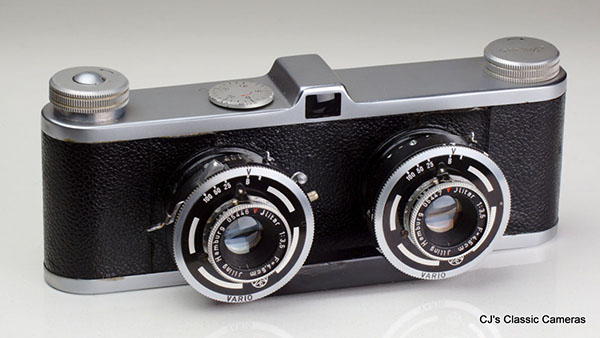
The very first version of the Iloca Stereo. I am not quite sure if this was a prototype or a regular production model, but it is different from all the later Iloca Stereo v.1 that I have seen (which are all the same, see below for details). The only comparable Stereo I I have seen is on this undated leaflet.
To allow two pictures to be taken simultaneously without losing costly film, film frames would alternate, i.e., stereo pairs were not next to each other. For this to work one had to wind the film alternately one frame and then three frames after the previous exposure. It was thus essential to turn the wind knob as far as it would go. The Iloca Stereo was a 7 sprocket camera (film frames were 7 sprocket holes wide, essentially the same as a normal full frame 36x24mm format). Most later models, including the Ilocas from the Stereo II onwards, were 5 sprocket cameras, with narrower film frames that allowed more compact cameras and would advance two frames each time one would wind the camera.
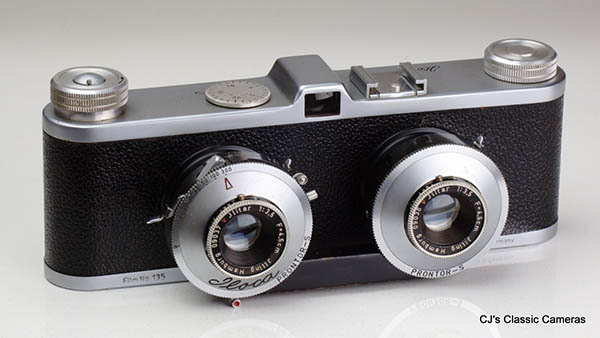
A main production Iloca Stereo v.1, although almost certainly the accessory shoe was added later. The small black bar between the lenses hid the lever that coupled the two shutters.
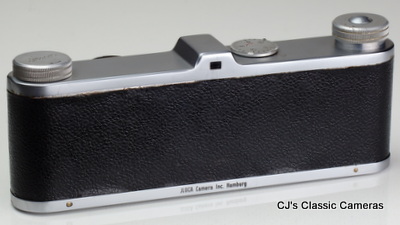
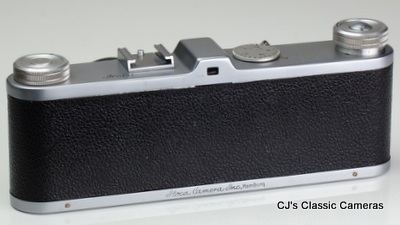
| Rear view of the two Iloca Stereo v.1 models shown above. Note several differences, including the wind knobs that are different, there is no 'Iloca' logo engraved on top of the first model, whereas the 'Iloca Camera Inc. Hamburg' engraving on the back of the bottom plate is not yet in the characteristic italic font of the later models. |
Iloca Stereo v.2
Fairly soon after the initial introduction of the Iloca Stereo a slightly modified version was introduced. The most obvious difference was the characteristic metal plate engraved with 'Iloca Stereo' located inbetween the two lenses, but there were also functional improvements, such as coupled lens focussing and aperture control.
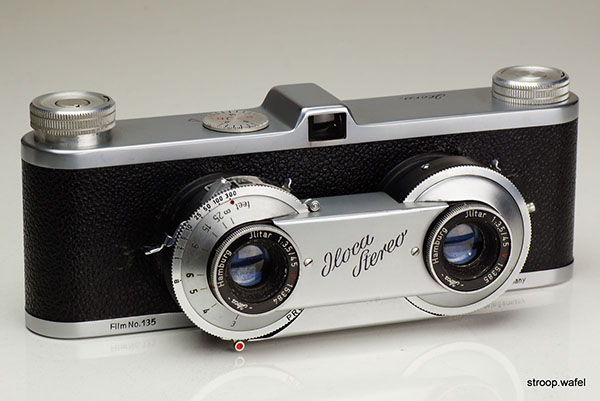
The second version of the Iloca Stereo. This one is a little unusual as it has lenses marked 'Iloca', all the others I have seen are marked 'Illing'. Like the Iloca I models, this one is bottom-loading and one needs to cut a longer film leader to load film properly, just like on contemporary Leicas.
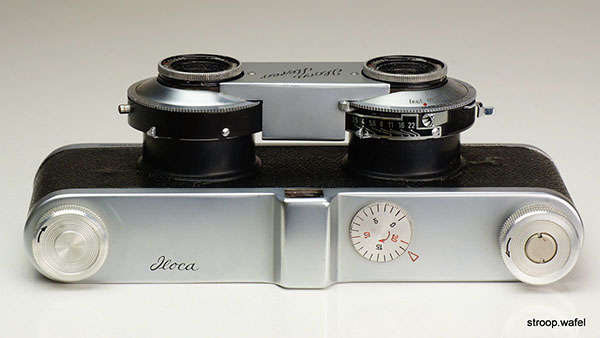
Top view of the Iloca Stereo v.2. The cover between the lenses hides three belts that connect the aperture, focus and shutter release mechanisms of the two shutters.
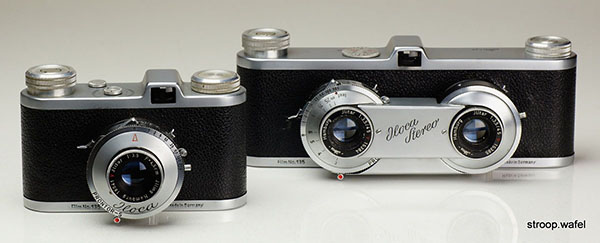
An Iloca Stereo v.2 with an Iloca I, showing the similarity between the two.
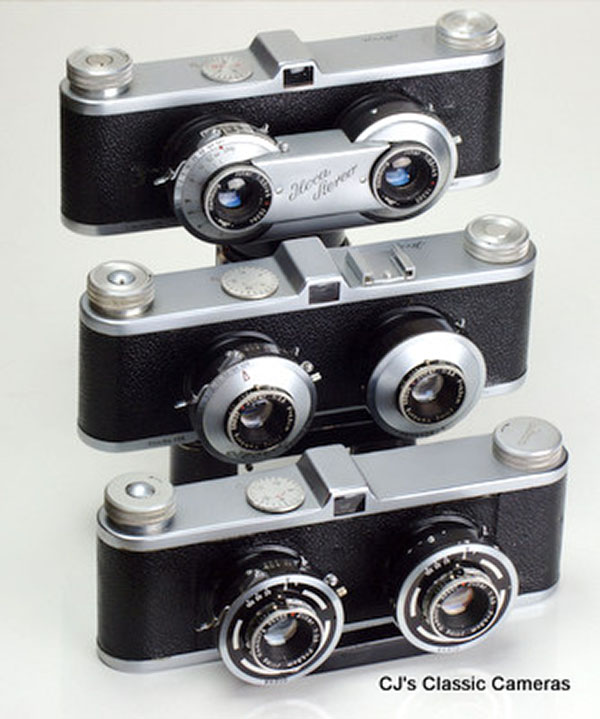
|
All three Iloca Stereo models side by side.
|
Iloca Stereo II
The Iloca Stereo II was introduced in 1952, before the Iloca Quick was introduced. Nevertheless, its styling was most similar to the Iloca Quick v.3 with a large rectangular metal strip around the body front. However, the comparison ends there. The Stereo two has a viewfinder at the bottom of the camera (!), the concentric circles design of the wind knobs is unique and the shutter is cocked by pulling a small lever on the wind knob. The camera took small, square 24x24mm pictures in the 5 sprocket format (see above). All in all quite a curious camera.
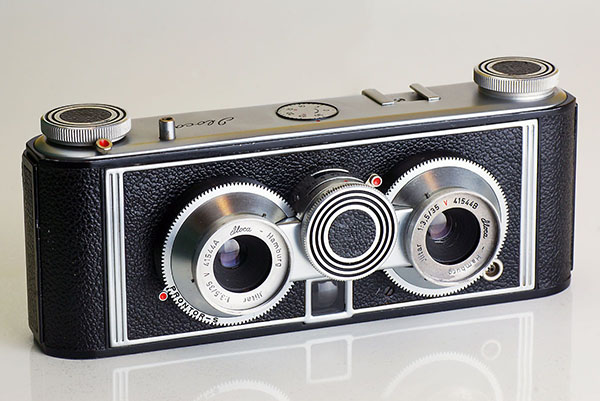
An Iloca Stereo II. The metal of the lenses was heavily corroded, this shows the camera midway polishing them up. It was in excellent working condition otherwise. The lever with the red dot in the middle adjusts the aperture of both lenses. The shutter speed is set by twisting the right lens speed ring, the setting can be read in a little window behind the aperture adjustment. The aperture setting is transferred to the other lens through a gear system.
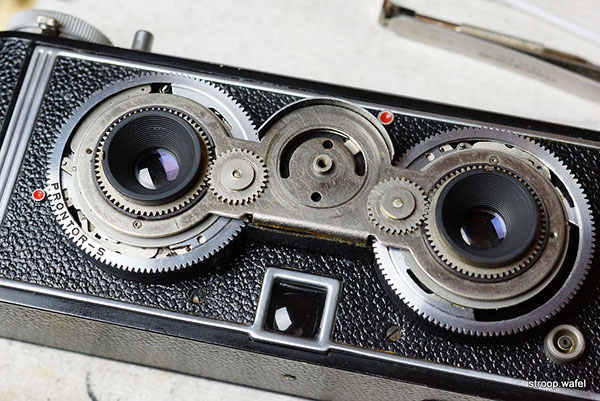
Some of the gear system for setting aperture and shutter speed for both stereo lenses.
Iloca Stereo IIa
The Stereo IIa is a slightly modified, more modern looking version of the Stereo II. It was clad in brown leather and had a larger top housing. The front plate was metal instead of leather.
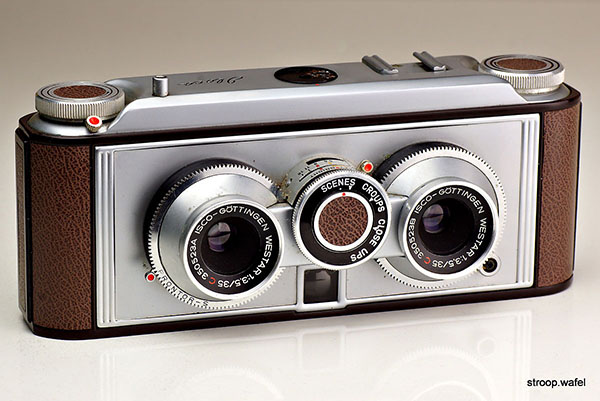
An Iloca Stereo IIa. This particular one is rather unusual as it has ISCO Westar lenses and markings to aid focussing and exposure, normally found on the Tower 83 version. So this looks like a model built to be sold as a Tower 83 but sold as Iloca instead. In case you are wondering, the frame counter is missing on this one.
Iloca Stereo Rapid I
While the Iloca Stereo II and IIa could be regarded as the stereo versions of the Iloca Quick, the Iloca Rapid Stereo was, unsurprisingly, the stereo variant of the Iloca Rapid. The styling was rather similar to the Iloca Stereo IIa with its brown leather and metal front plate, but the Stereo Rapid featured a foldable wind lever on the left hand side, just like the early Rapid series cameras. Other new features were a frame counter that would reset automatically to zero when opening the back of the camera and a film reminder dial. The film format was the same as on the Stereo II model.
The focus system was different from earlier Iloca Stereo versions and in fact different from most other cameras in general: instead of rotating the front-cell or moving the whole lens on a helicoid, it was the film gate which moved forwards and backwards! I am not sure how well this worked in practice, as changing focus would pull film out of the cartridge and possibly cause problems with film flatness, but perhaps the pressure plate did a good enough job keeping the film flat.
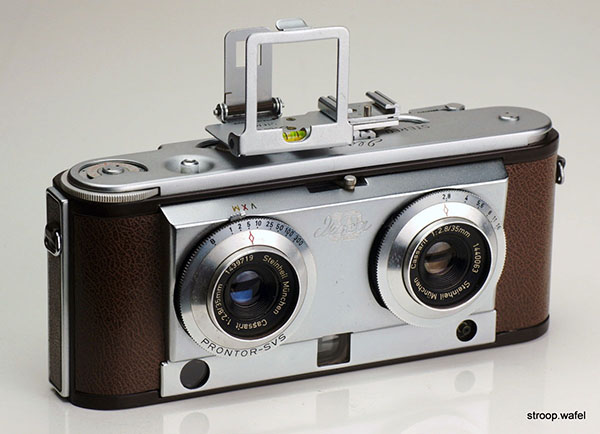
An Iloca Stereo Rapid I with two Steinheil Cassarit 35mm f/2.8 lenses in Prontor-SVS shutters. On top it has a sports finder mounted which included a spirit level as well as an extra accessory shoe mount.
The speed control and aperture rings were located each on a different lens. Note also the small lever in-between the lenses near the top of the camera, which would allow to cock the shutter without winding the film. This was designed to make double exposures, but also allowed to use the camera in 'single image' mode by transporting the film with the rapid lever as normal, covering one of the lenses and taking a shot, cocking the shutter with the small lever, covering the other lens and taking the second shot.
There were two versions of the Iloca Stereo Rapid, one with coupled rangefinder and f/2.8 maximum aperture lenses, and a cheaper one with a simple viewfinder and f/3.5 lenses (see Stereograms version below). A model identical to the Stereo Rapid I but clad in black leather was sold under license by Stereograms in the UK (see below). Several interesting accessories were available for the Iloca Stereo Rapid range, including a close-focus adapter, a highly desirable Steinheil 25mm wide-angle adapter and a frame finder with spirit level.
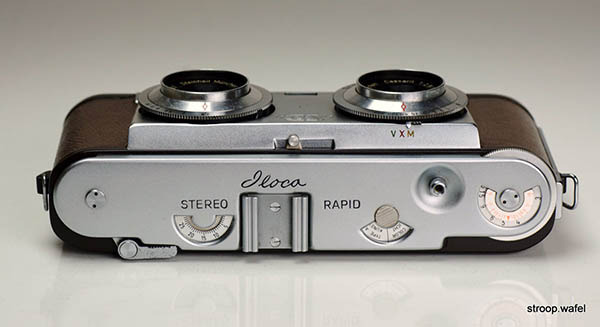
Top view of an Iloca Stereo Rapid I showing the foldable rapid wind lever on the left and the focus wheel on the right.
Stereograms Iloca 3.5
The Stereograms Iloca 3.5 was essentially an Iloca Stereo Rapid II, the viewfinder version with f/3.5 lenses and Vero shutters of the Iloca Stereo Rapid. The only differences between the Stereograms and original Iloca versions appears to have been the Stereograms logo on the front replacing the Iloca 3D logo and the presence of an accessory shoe with build-in flash connection (i.e., a hot shoe) instead of the flash contact next to the viewfinder window. Incidentally, this was one of the very few cameras made by Iloca that had a hot shoe, the only other one I am aware of being the Argus V-100.
The Stereograms cameras were reportedly produced by MPP in the UK, which also produced a version of the Iloca Rapid IL, to avoid import restrictions. It seems a little surprising to me that this scheme worked, as the camera still had the Iloca Stereo Rapid engraving on its top housing. In the UK, this version of the Stereograms was about 15% cheaper than the rangefinder version with faster lenses and better shutter below. That does not seem to have been much of a discount, which may explain its relative rarity.
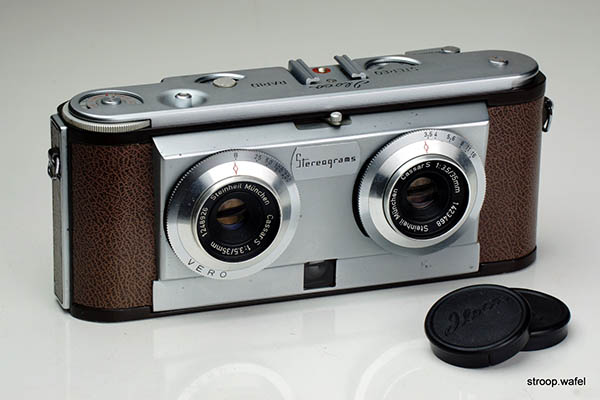
A Stereograms Iloca 3.5 with Cassar 35mm f/3.5 lenses in Vero shutters.
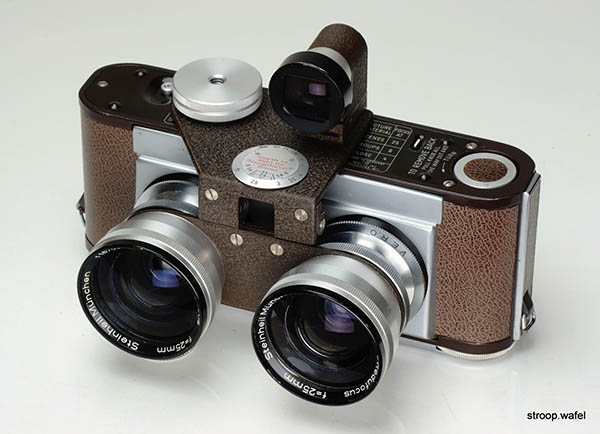
The same Stereograms Iloca here shown with a Steinheil Redufocus attachment, which was used to adjust the focal length of the lenses to 25mm, equivalent to about 35mm on full frame. The accessory came with an adjusted depth of field scale as well as a dedicated viewfinder. A peculiar feature was that it needed to be mounted to the bottom of the camera so effectively the viewfinder was below the camera.
Stereograms Iloca 2.8
The Stereograms Iloca 2.8 was the UK version of the Iloca Stereo Rapid I (see above), the main difference being the colour of the leather covering, which was black on the Sterograms but brown on the Iloca version. Also, the name 'Stereograms' was engraved in the top plate and it was missing the name Iloca. Finally, the body numbering also appears to have been different. The example below has #4014 engraved on the inside, whereas all other Ilocas had a six-digit body number (plus sometimes a three number date indicator). In contrast, the Stereograms 3.5 had the regular 'Iloca' numbering.
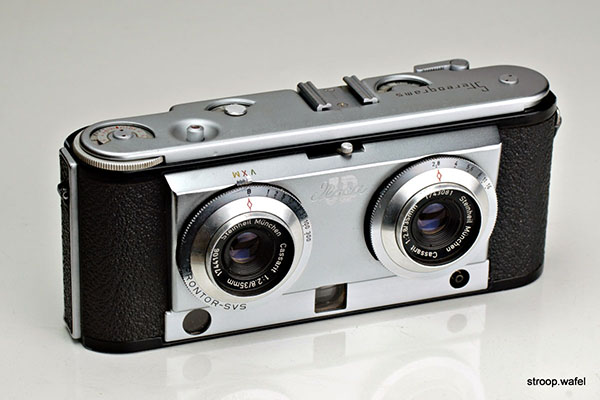
A Stereograms Iloca 2.8 with Steinheil Cassarit 35mm f/2.8 lenses in Prontor-SVS shutters.
Iloca Stereo viewer
Many companies produced stereo viewers to accompany their stereo cameras and Iloca was no exception. These viewers were to be used with stereo slides, which were cardboard strips with two slides (a stereo pair) mounted at a fix distance from each other. The Iloca viewer had internal illumination by means of two CC batteries, the light would only come on with a slide inserted. The viewer had adjustments for focus and distance between the eyes.
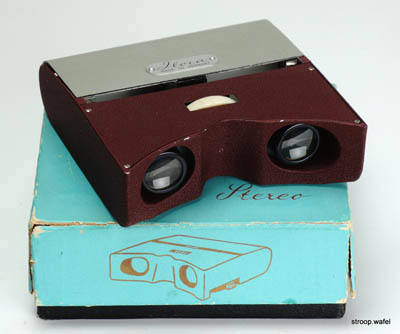
|
Iloca Stereo viewer with its original box.
|
Link:
See www.stereoscopy.com/faq/filmformat.html for examples of the stereo film formats.
| 
